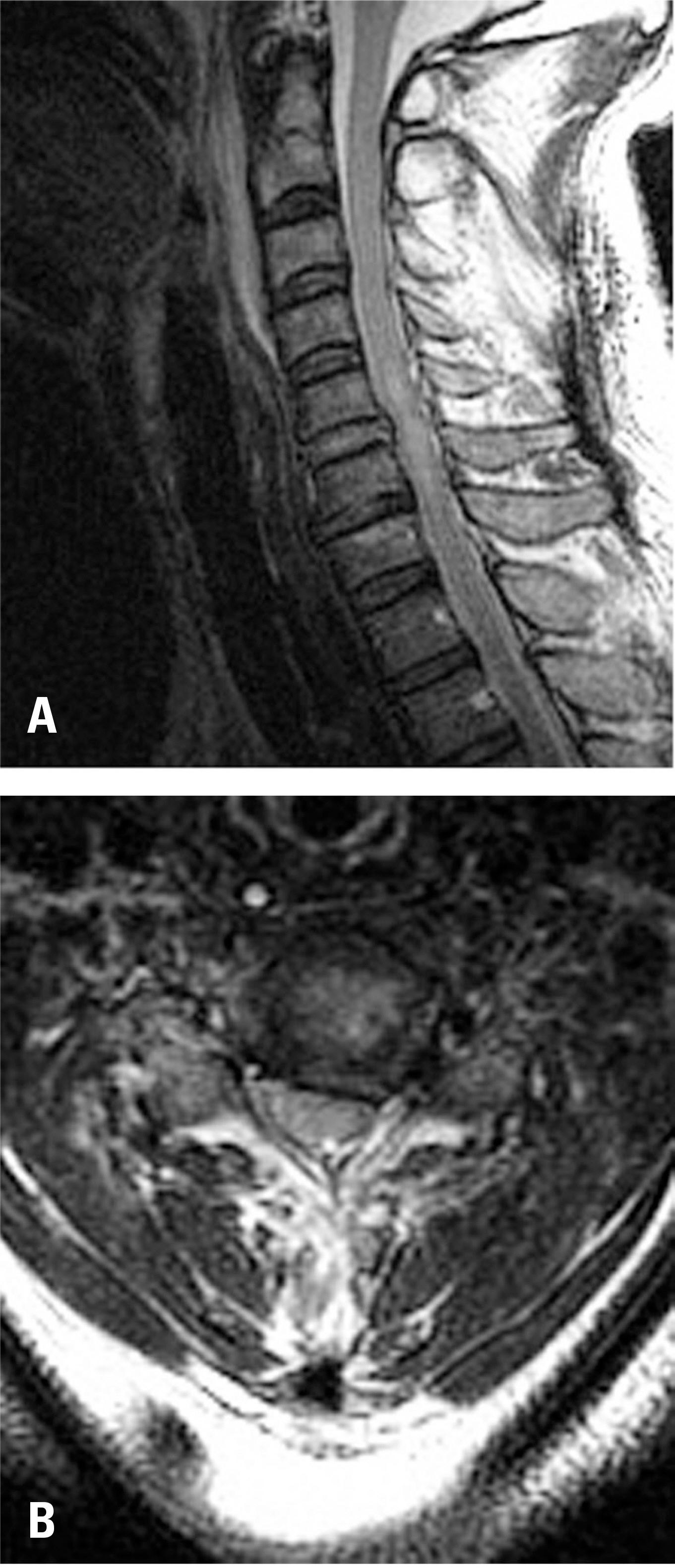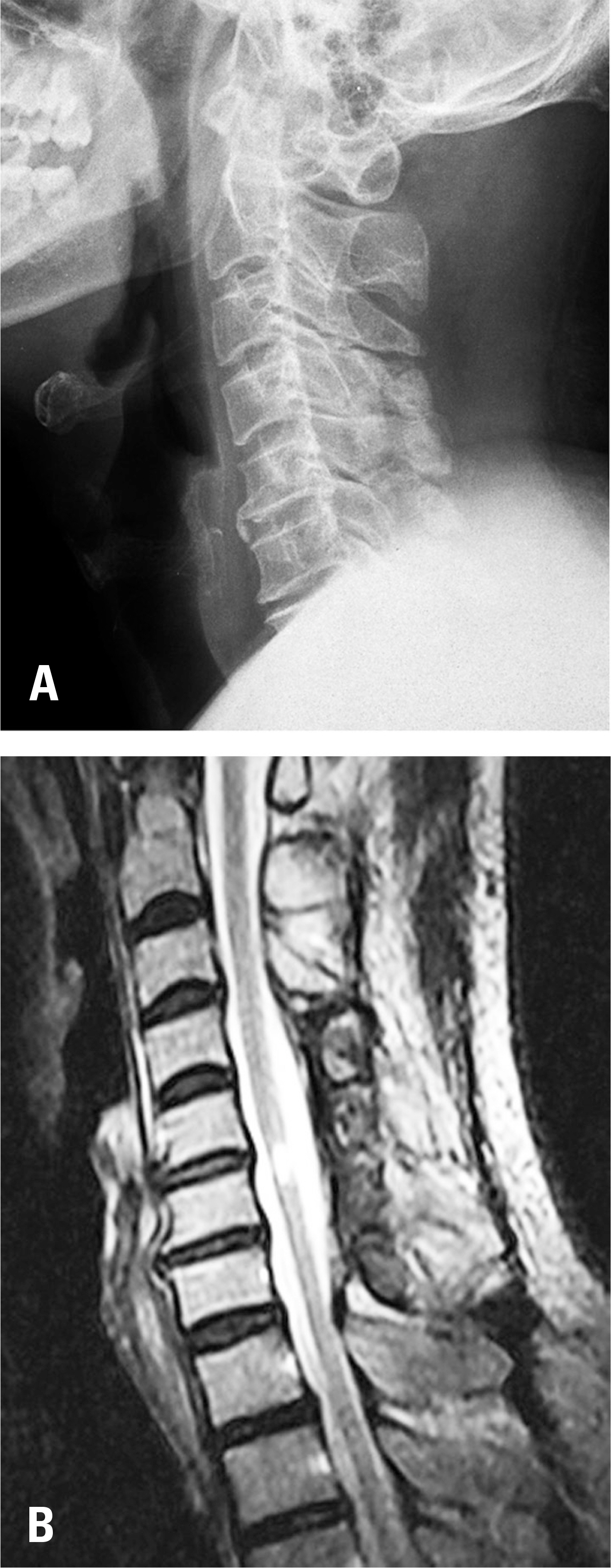J Korean Soc Spine Surg.
2017 Dec;24(4):231-235. 10.4184/jkss.2017.24.4.231.
Efficacy of Cervical Expansive Laminoplasty for Quadriplegic Patients Without Cervical Bony Injury
- Affiliations
-
- 1Department of Orthopedic Surgery, Chonnam National University Hospital, Gwangju, Korea. hyseo2001@hanmail.net
- KMID: 2408191
- DOI: http://doi.org/10.4184/jkss.2017.24.4.231
Abstract
- STUDY DESIGN: Retrospective study.
OBJECTIVES
To evaluate the efficacy of cervical expansive laminoplasty for patients with quadriplegia due to traumatic cervical spinal cord injury (SCI) without skeletal injury. SUMMARY OF LITERATURE REVIEW: There are a few studies on the surgical results for acute cervical SCI without bony injury.
MATERIALS AND METHODS
From 2003 to 2010, among the patients who visited emergency room with post-traumatic quadriplegia, 12 patients who had underwent cervical expansive laminoplasty for acute cervical SCI without body injury and cord compression on MR images were included in this study. We evaluate the pre-operative swelling on MRI, the change of neurologic symptoms at pre-, post operative state, respiration state, complication and survival period.
RESULTS
The average of motor index scores at the time of admission to the emergency room was 23 (4-30), and the average was changed to 29(4-43) during the follow-up period. No significant neurological improvement was observed in 11 cases except 1 case. The average time for operation after the injury was 26 hours(9-72). 4 patients showed paradoxical respiration when they first visited emergency room and the symptom continued after the operation and during follow-up periods. Another 4 patients showed paradoxical respiration after the operation. In all 8 cases who showed paradoxical respiration, tracheostomy and occasional ventilation were needed. In the follow-up period, 6 patients died due to respiratory failure within 1 year after the surgery. All these patients presented severe spinal cord edema on preoperative MRI with paradoxical respiration.
CONCLUSIONS
Efficacy of expansive laminoplasty for quadriplegic patients due to acute cervical SCI without bony injury may be limited. In many patients, no significant neurological recovery was observed but it was clearly identified that prognosis was related to the grades of spinal cord edema and paradoxical respiration.
MeSH Terms
Figure
Reference
-
1. Bohlman HH. Acute fracture and dislocation of the cervical spine. An analysis of three hundred hospitalized patients and review of the literature. J Bone Joint Surg Am. 1979 Dec; 61(8):1119–42.2. Song KJ, Lee KB. The Prognosis of the Acute Cervical Spinal Cord Injury. J Korean Orthop Assoc. 1998 Jun; 33(3):794–801.
Article3. Ahn JS. Acute Spinal Cord Injury. J Korean Soc Spine Surg. 2000 Sep; 7(3):431–8.4. Jeong ST, Kim JS, Cho SH, et al. The Laminoplasty for Acute Cervical Spinal Cord Injury in Cervical Spondylosis. J Korean Orthop Assoc. 2005 Oct; 40(6):667–72.
Article5. Kurokawa T, Tsuyama N, Tanaka H, et al. Double-door laminoplasty. Bessatsu Seikeigeka. 1982; 2:234–40.6. Koyanagi I, Iwasaki Y, Hida K, et al. Acute cervical cord injury without fracture or dislocation of spinal column. J Neurosurg. 2000 Jul; 93(1 Suppl):15–20.7. Ducker TB, Bellegarrigue R, Salcman M, et al. Timing of operative care in cervical spinal cord injury. Spine (Phila Pa 1976). 1984 Jul-Aug; 9(5):525–31.
Article8. Yang JY, Lee JK, Hong CH, et al. Assessment of Quality of Life and Psychological Status in Spinal Cord Injury after Spinal Fracture. J Korean Soc Spine Surg. 2004 Dec; 11(4):285–90. DOI: 10.4184/jkss.2004.11.4.285.
Article9. Kasimatis GB, Panagiotopoulos E, Megas P, et al. The adult spinal cord injury without radiographic abnormalities syndrome: magnetic resonance imaging and clinical findings in adults with spinal cord injuries having normal radiographs and computed tomography studies. J Trauma. 2008 Jul; 65(1):86–93. DOI: 10.1097/TA.0b013e318157495a.
Article10. Sun LQ, Shen Y, Li YM, et al. Prediction of prognosis in patients with cervical spinal cord injury without radiologic evidence of trauma using MRI. Orthopedics. 2014 Mar; 37(3):E302–6. DOI: 10.3928/01477447-20140225-65.
Article11. Song KJ, Lee KB, Hwang BY, et al. Relationship between Soft Tissue Damages and Spinal Cord Injury in Lower Cervical Spine Trauma. J Korean Orthop Assoc. 2005 Oct; 40(6):686–93.
Article
- Full Text Links
- Actions
-
Cited
- CITED
-
- Close
- Share
- Similar articles
-
- Expansive Laminoplasty for Cervical Compression Myelopathy
- Box-Shape Cervical Expansive Laminoplasty: Clinical and Radiological Outcomes
- New Cervical Laminoplasty Polyethererketone Cage: Two Case Reports
- Cervical Ossification of Posterior Longitudinal Ligament in X-Linked Hypophosphatemic Rickets Revealing Homogeneously Increased Vertebral Bone Density
- Novel Hybrid Hydroxyapatite Spacers Ensure Sufficient Bone Bonding in Cervical Laminoplasty



